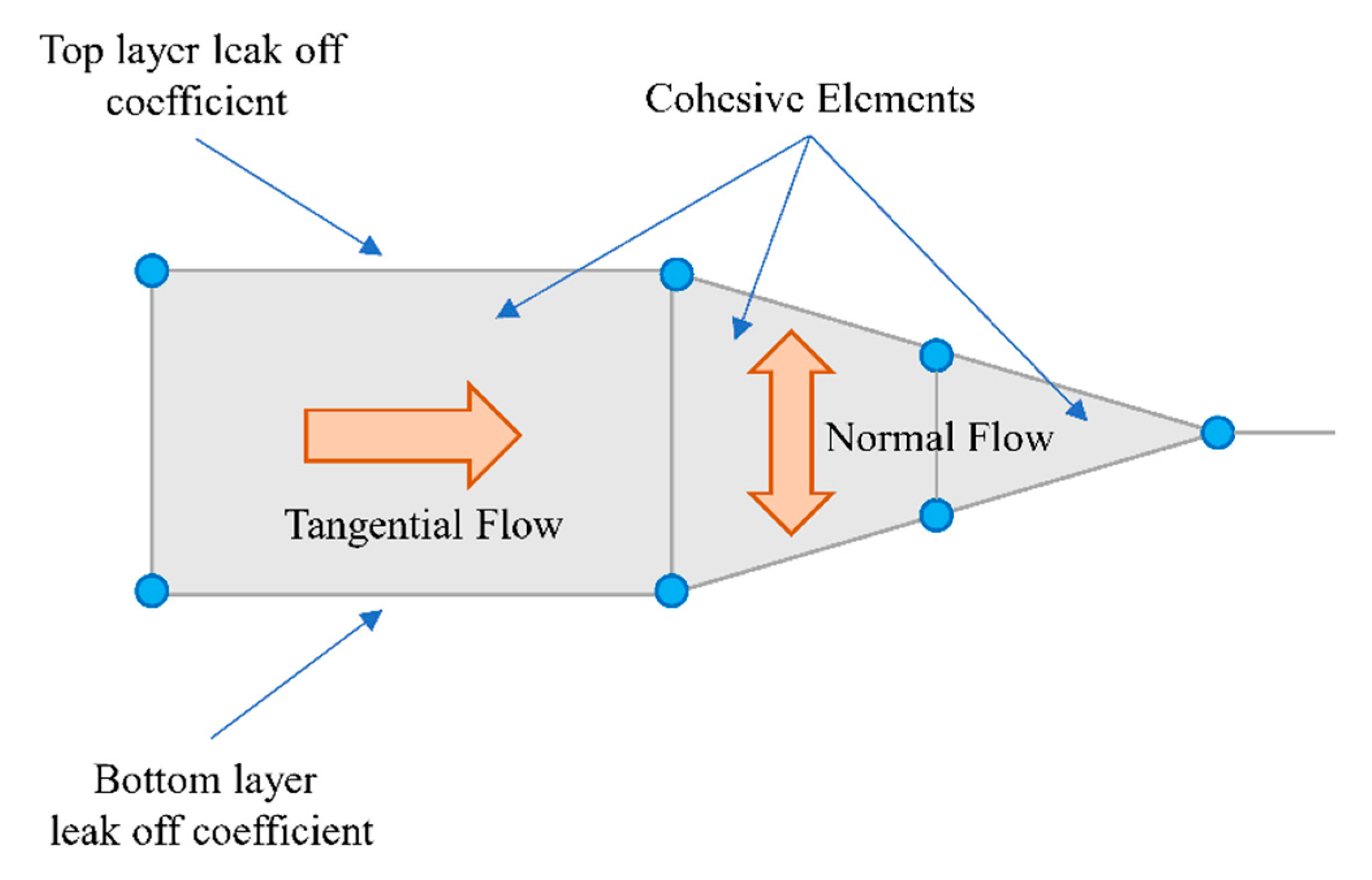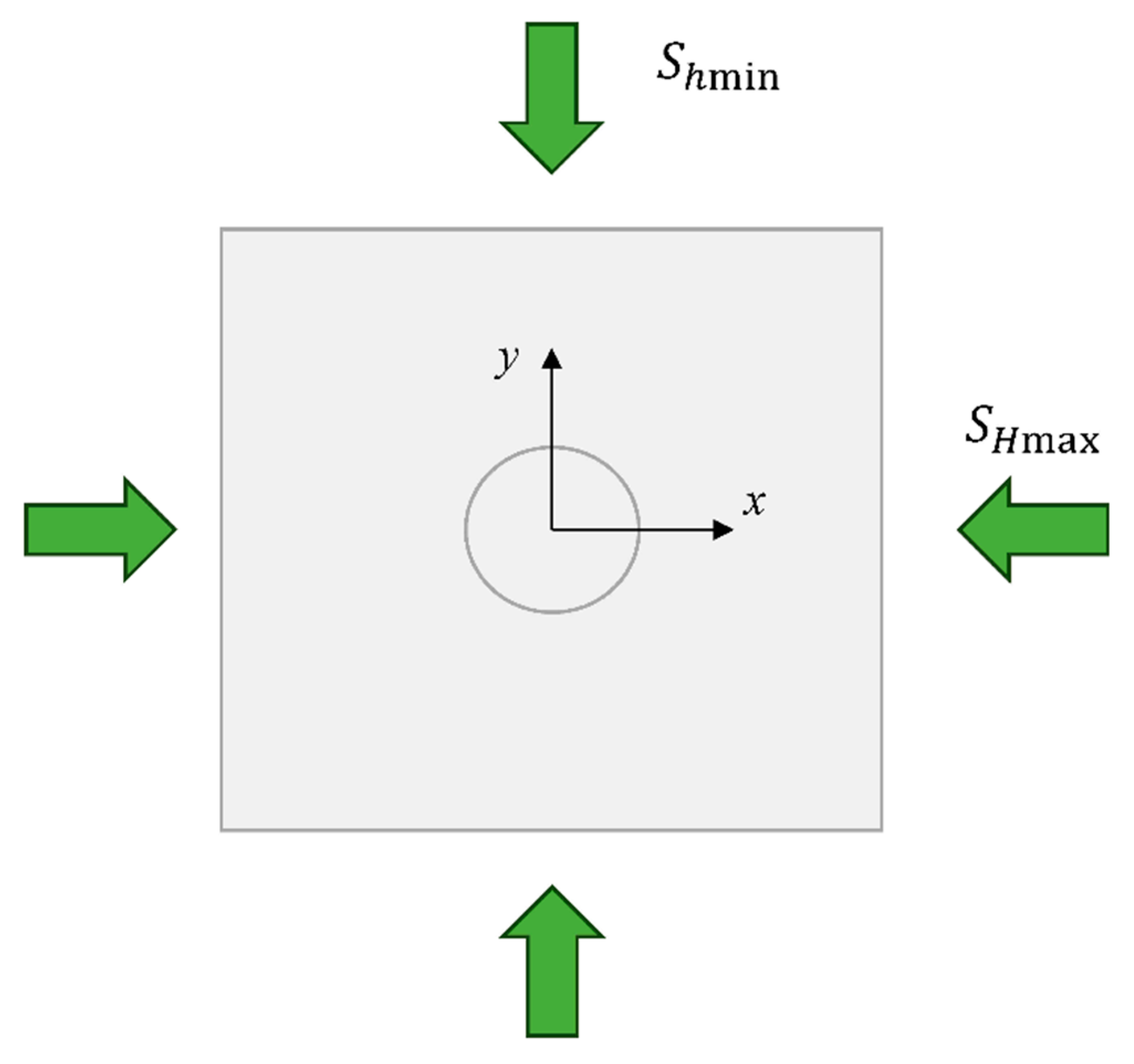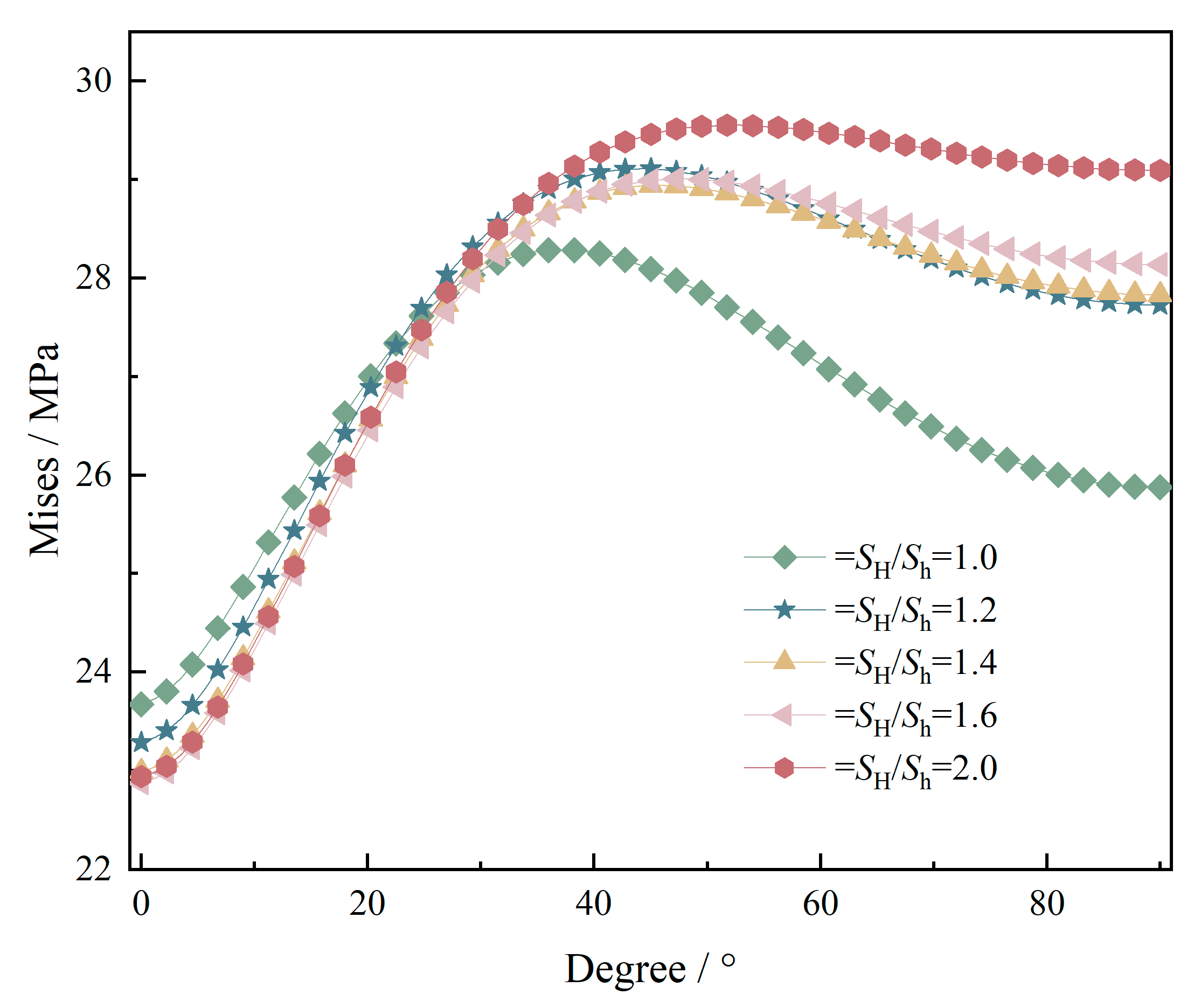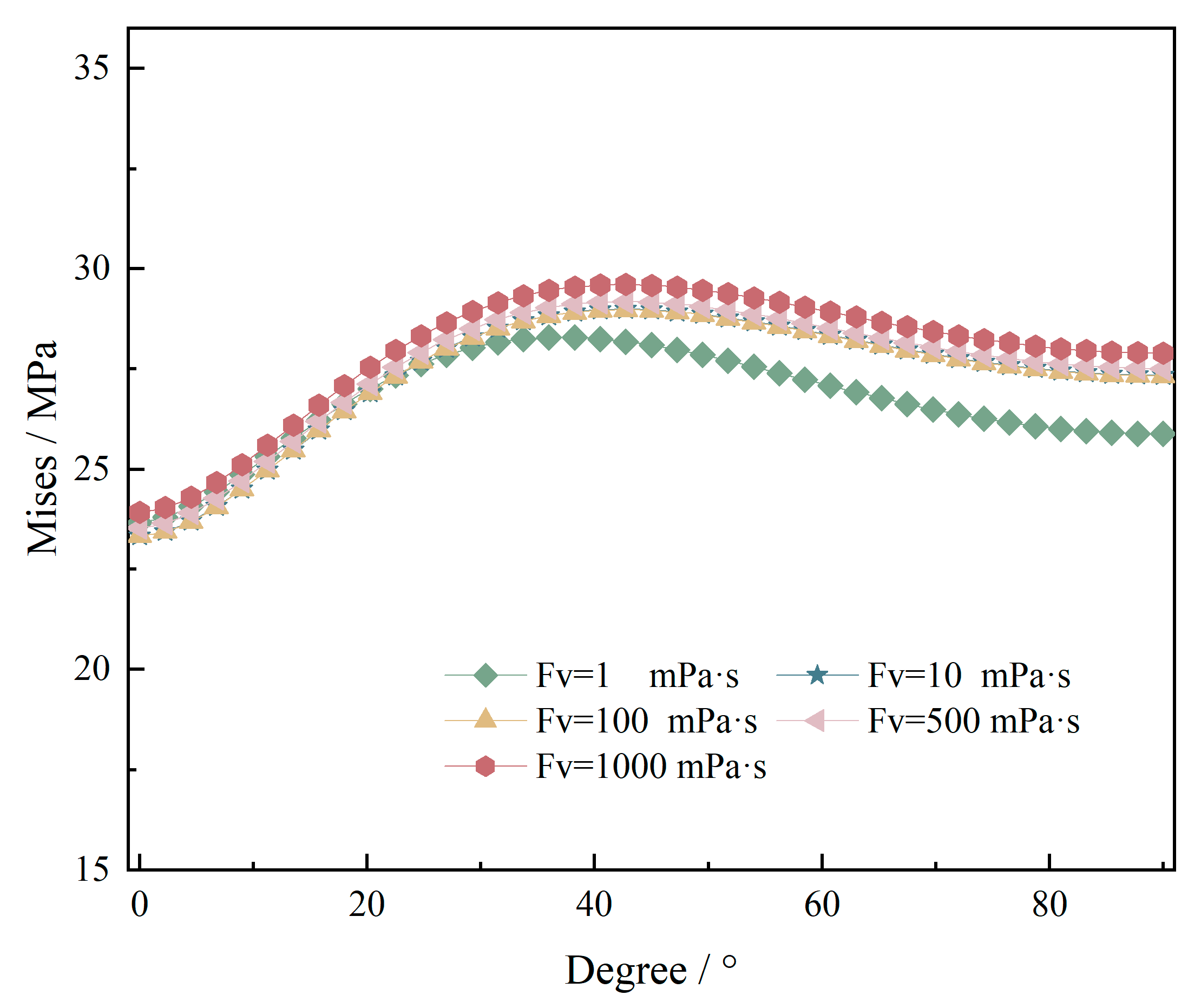Research on the Mechanism of Wellbore Strengthening Influence Based on Finite Element Model
Abstract
1. Introduction
2. Mathematical Models
2.1. Cohesive Zone Model

2.2. Principle of Virtual Work
2.3. Constitutive and Seepage Equations
2.4. Control Equation
3. Model Establishment
3.1. Model Geometry
3.2. Boundary Conditions
3.3. Input Parameters
4. Simulation Results and Parameter Analysis
4.1. Influence of Anisotropy of Geostress
4.2. Influence of Elastic Modulus
4.3. Influence of Poisson’s Ratio
4.4. Influence of Fracturing Fluid Viscosity
5. Conclusions
- (1)
- As the horizontal stress difference (SH/Sh) increases, the peak Mises stress around the wellbore significantly increases, and the anisotropy of stress exacerbates the risk of wellbore instability. When SH/Sh > 1.4, it is necessary to strengthen wellbore reinforcement and pressure control and optimize wellbore orientation to avoid high stress concentration areas. The stress isotropic (SH/Sh = 1) condition has the best stability.
- (2)
- The increase in reservoir elastic modulus (10–30 GPa) leads to an increase in Mises stress around the wellbore, with significant stress concentration at the 30–40° azimuth angle. High modulus reservoirs (>20 GPa) are prone to wellbore instability due to increased rigidity, and it is necessary to optimize sealing materials to alleviate stress concentration; low modulus reservoirs (<15 GPa) have strong deformation ability but need to prevent wellbore shrinkage. Elastic modulus is a key control parameter for sealing design and wellbore stability.
- (3)
- An increase in Poisson’s ratio (0.20~0.30) leads to a decrease in Mises stress around the wellbore, while low Poisson’s ratio (<0.25) results in more significant stress concentration in the reservoir, requiring strengthened sealing measures; high Poisson’s ratio (>0.28) reservoirs have a smoother stress distribution and better stability. Compared to the difference in geostress and elastic modulus, Poisson’s ratio has a weaker impact, but it is still necessary to optimize the sealing design in low Poisson’s ratio reservoirs to reduce the risk of instability.
- (4)
- The increase in viscosity of fracturing fluid leads to an increase in Mises stress around the well, with the most significant stress concentration occurring at a 40° azimuth angle. High viscosity (>500 mPa · s) fracturing fluid exacerbates wellbore stress concentration, and viscosity optimization is needed to balance sealing effectiveness and stability; although low viscosity (<10 mPa · s) results in lower stress, the sealing efficiency may be insufficient. The influence of viscosity is weaker than that of stress difference and elastic modulus, but it still needs to be reasonably controlled during construction.
Author Contributions
Funding
Data Availability Statement
Conflicts of Interest
References
- Jin, H.Z.; Peng, Q.Y. Research on the development of modern drilling technology and the trend of exploration and development of oil and gas resources. China Pet. Chem. Stand. Qual. 2013, 33, 187. [Google Scholar]
- Kang, Y.L.; Xu, C.Y.; Tang, L.; Li, S.; Li, D. Constructing a tough shield around the wellbore: Theory and method for lost circulation control. Pet. Explor. Dev. 2014, 41, 473–479. [Google Scholar] [CrossRef]
- Wei, J.F.; Liu, S.Q. Research on the influence of international oil price fluctuation on China’s oil market under the new situation. Enterp. Hebei 2024, 7, 29–32. [Google Scholar]
- Peter, J.B.; Reddy, B.R.; Hillfiger, M.; O’connell, T.P.; Thaemlitz, C. Functionalized nanosilicas as shale inhibitors in water-based drilling fluids. In Proceedings of the Offshore Technology Conference, SPE-26902. Houston, TX, USA, 2–5 May 2016. [Google Scholar]
- Huang, N.S. Research progress on the mechanism of improving the pressure-bearing capacity of fractured formation. Drill. Prod. Technol. 2023, 46, 133–138. [Google Scholar]
- Lv, K.H. Study and Application of Lost Circulation Resistance and Control Technology During Drilling; China University of Petroleum: Beijing, China, 2007. [Google Scholar]
- Wang, G. Theory and Technology on Drilling Fluids for Wellbore Strengthening; Southwest Petroleum University: Chengdu, China, 2012. [Google Scholar]
- Li, J.; Qiu, Z.S.; Song, D.D.; Liu, J.; Zhong, H.; Wang, W. Numeric simulation of factors affecting the strengthening of borehole wall. Drill. Fluid Complet. Fluid 2017, 34, 1–8. [Google Scholar]
- Wang, H.; Towler, B.F.; Mohamed, S. Fractured wellbore stress analysis: Sealing cracks to strengthen a wellbore. In Proceedings of the SPE/IADC Drilling Conference, SPE-104947-MS. Amsterdam, The Netherlands, 20–22 February 2007. [Google Scholar]
- Cook, J.; Growcock, F.; Guo, Q.; Hodder, M.; van Oort, E. Stabilizing the well-bore to prevent lost cicrulation. Oilfield Rev. 2011, 23, 26–35. [Google Scholar]
- Sun, J.; Bai, Y.; Cheng, R.; Lyu, K.; Liu, F.; Feng, J.; Lei, S.; Zhang, J.; Hao, H. Research progress and prospect of plugging technologies for fractured formation with severe lost circulation. Pet. Explor. Dev. 2021, 48, 630–638. [Google Scholar] [CrossRef]
- Su, X.M.; Lian, Z.H.; Fang, J.W.; Xiong, H.; Wu, R.; Yuan, Y. Lost circulation material for abnormally high temperature and pressure fractured-vuggy carbonate reservoirs in Tazhong block, Tarim Basin, NW China. Pet. Explor. Dev. 2019, 46, 165–172. [Google Scholar] [CrossRef]
- Chen, W.; Liu, J.; Peng, W.; Zhao, Y.; Luo, S.; Wan, W.; Wu, Q.; Wang, Y.; Li, S.; Tang, X.; et al. Aging deterioration of mechanical properties on coal-rock combinations considering hydro-chemical corrosion. Energy 2023, 282, 128770. [Google Scholar] [CrossRef]
- Lu, X.C.; Fan, B.T.; Zhao, Z.J. New research progress on wellbore strengthening technology. Drill. Fluid Complet. Fluid 2013, 29, 74–78. [Google Scholar]
- Li, S.; Kang, Y.L.; Li, D.Q.; Zhang, D.; Zhou, C. Diagnosis system for characterizing lost circulation in troublesome formations. Drill. Fluid Complet. Fluid 2015, 32, 89–95. [Google Scholar]
- Wang, Y.Z.; Hou, B.; Wang, D.; Jia, Z.H. Features of fracture height propagation in cross-layer fracturing of shale oil reservoirs. Pet. Elplor. Dev. 2021, 48, 402–410. [Google Scholar] [CrossRef]
- Song, D.D.; Qiu, Z.S.; Wang, C.; Liu, J.; Wang, Q.; Zhong, H.; Zhao, X. Numerical simulation of borehole wall strengthening using ABAQUA. Drill. Fluid Complet. Fluid 2016, 33, 15–19. [Google Scholar]
- Morita, N.; Black, A.D.; Fuh, G.F. Theory of Lost Circulation Pressure. In Proceedings of the SPE Annual Technical Conference and Exhibition, SPE-20409-MS. New Orleans, LA, USA, 23–26 September 1990. SPE-20409-MS. [Google Scholar]
- Wang, F.W.; Liu, K.Q.; Qiu, Z.S. Research progress of wellbore stability analysis model in foreign. J. Yanan Univ. (Nat. Sci. Ed.) 2014, 1, 82–87. [Google Scholar]
- Dugdale, D.S. Yielding of steel sheets containing slits. J. Mech. Phys. Solids 1960, 8, 100–104. [Google Scholar] [CrossRef]
- Chen, Z.; Bunger, A.; Zhang, X.; Jeffrey, R.G. Cohesive zone finite element-based modeling of hydraulic fractures. Acta Mech. Solida Sin. 2009, 22, 443–452. [Google Scholar] [CrossRef]
- Roe, K.L.; Siegmund, T. An irreversible cohesive zone model for interface fatigue crack growth simulation. Eng. Fract. Mech. 2003, 70, 209–232. [Google Scholar] [CrossRef]
- Salehi, S.; Nygaard, R. Full fluid-solid cohesive finite-element model to simulate near wellbore fractures. J. Energy Resour. Technol. 2015, 137, 012903. [Google Scholar] [CrossRef]
- Carrier, B.; Granet, S. Numerical modeling of hydraulic fracture problem in permeable medium using cohesive zone model. Eng. Fract. Mech. 2012, 79, 312–328. [Google Scholar] [CrossRef]
- Snow, D.T. Anisotropie permeability of fractured media. Water Resour. Res. 1969, 5, 1273–1289. [Google Scholar] [CrossRef]
- Han, L.; Shi, X.; Ni, H.J.; Zhang, W.D.; Ge, X.X.; Yang, Y.Y.; Zhang, J.C.; Yu, T.X.; Lu, M.J.; Poplygin, V. Optimization of supercritical CO2 fracturing based on random forest—Particle swarm optimization model and pre-existing fracture network. SPE J. 2024, 29, 5957–5975. [Google Scholar] [CrossRef]
- Biot, M.A. General theory of three-dimensional consolidation. J. Appl. Phys. 1941, 12, 155–164. [Google Scholar] [CrossRef]
- Feng, Y.C.; Gray, K.E. A parametric study for wellbore strengthening. J. Nat. Gas Sci. Eng. 2016, 30, 350–363. [Google Scholar] [CrossRef]
- Alberty, M.W.; Mclean, M.R. A physical model for stress cages. In Proceedings of the SPE Annual Technical Conference and Exhibition, Houston, TX, USA, 26–29 September 2004. [Google Scholar]
- Wang, H.; Soliman, M.Y.; Tower, B.F. Investigation of factors for strengthening a wellbore by propping fractures. SPE Drill. Complet. 2009, 24, 441–451. [Google Scholar] [CrossRef]
- Jiang, C.Y.; Wang, X.G.; Jourde, H. Dam leakage potential related to karstification in limestone bedrock: Effects of temperature and stress-induced anisotropy. J. Hydrol. 2025, 657, 133061. [Google Scholar] [CrossRef]








| Parameter | Value | Units | |
|---|---|---|---|
| Reservoir | Model dimension | 2 × 1.5 | m |
| Wellbore diameter | 0.10795 | m | |
| Elastic modulus | 15 | GPa | |
| Poisson’s ratio | 0.25 | / | |
| Permeability coefficient | 1 × 10−7 | m/s | |
| Void ratio | 0.2 | / | |
| Minimum horizontal principal stress | 10 | MPa | |
| Maximum horizontal principal stress | 10~20 | MPa | |
| Cohesive element | Tensile strength | 1 | MPa |
| Shear strength | 5 | MPa | |
| Elastic modulus | 15 | GPa | |
| Filtration coefficient | 1 × 10−14 | m3/s/Pa | |
| Viscosity | 1 | mPa·s | |
| Other | Displacement | −0.005 | m3/s |
| Simulation time | 50 | s | |
| Fracture length | 0.1397 | m |
Disclaimer/Publisher’s Note: The statements, opinions and data contained in all publications are solely those of the individual author(s) and contributor(s) and not of MDPI and/or the editor(s). MDPI and/or the editor(s) disclaim responsibility for any injury to people or property resulting from any ideas, methods, instructions or products referred to in the content. |
© 2025 by the authors. Licensee MDPI, Basel, Switzerland. This article is an open access article distributed under the terms and conditions of the Creative Commons Attribution (CC BY) license (https://creativecommons.org/licenses/by/4.0/).
Share and Cite
Ai, E.; Li, Q.; Liu, Z.; Wang, L.; Ma, C. Research on the Mechanism of Wellbore Strengthening Influence Based on Finite Element Model. Processes 2025, 13, 2185. https://doi.org/10.3390/pr13072185
Ai E, Li Q, Liu Z, Wang L, Ma C. Research on the Mechanism of Wellbore Strengthening Influence Based on Finite Element Model. Processes. 2025; 13(7):2185. https://doi.org/10.3390/pr13072185
Chicago/Turabian StyleAi, Erxin, Qi Li, Zhikun Liu, Liupeng Wang, and Chengyun Ma. 2025. "Research on the Mechanism of Wellbore Strengthening Influence Based on Finite Element Model" Processes 13, no. 7: 2185. https://doi.org/10.3390/pr13072185
APA StyleAi, E., Li, Q., Liu, Z., Wang, L., & Ma, C. (2025). Research on the Mechanism of Wellbore Strengthening Influence Based on Finite Element Model. Processes, 13(7), 2185. https://doi.org/10.3390/pr13072185






